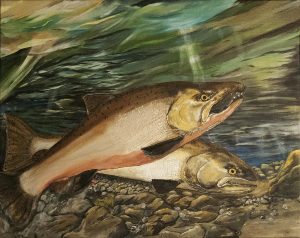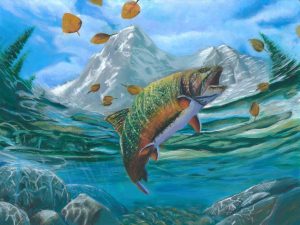 The Columbia City Yoga on-line Moving into Meditation class met this morning. We immersed ourselves in the contemplation of the wild salmon’s journey from their freshwater birthing waters out into to the vast ocean waters. They return pushing against tides and currents back to their birthing waters to spawn new life and then die. They are nourished and in return nourish hundreds of other species along the way. Their bodies’ nutrients are taken up by trees. The out-breath of trees becomes the in-breath of many other creatures including us. This web of inter-being is at the heart of our mindfulness practice. May we all realize our inter-being and be moved to compassionate action in the world.
The Columbia City Yoga on-line Moving into Meditation class met this morning. We immersed ourselves in the contemplation of the wild salmon’s journey from their freshwater birthing waters out into to the vast ocean waters. They return pushing against tides and currents back to their birthing waters to spawn new life and then die. They are nourished and in return nourish hundreds of other species along the way. Their bodies’ nutrients are taken up by trees. The out-breath of trees becomes the in-breath of many other creatures including us. This web of inter-being is at the heart of our mindfulness practice. May we all realize our inter-being and be moved to compassionate action in the world.
We were inspired by Alexandra Morton’s TEDx Seattle talk, What Humans Can Learn from the Wisdom of Salmon. Alexandra shares some of her moving experiences of studying whales, dolphins and salmon. She describes the inter-relationships between salmon and their greater habitat, including humans and more than humans. In 1980 she witnessed wild salmon migratory returns were crashing. She began studying their immune systems and discovered a virus transmitted by the farm raised Atlantic salmon. She and her team of researchers learned that by sampling the salmon along their migratory route back out into the Pacific ocean they could learn about the condition of ocean waters. Alexandra’s story is an inspirational call to care and to act to protect the lives of our more than human kin.
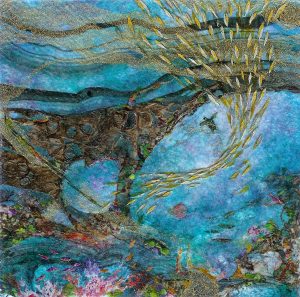 We heard from poet Jane Hirshfield’s On Being interview, The Fullness of Things. The fullness she refers to relates to the Buddhist perspective of accepting the suffering and perfection in life. The practice is a journey of feeling life’s joys and sorrows. She hopes that everyone’s journey includes a moment when “they stood in the world, undone by awe and radiance, and the small self vanishes, and you understand the world as immense and yours, and not yours. . . . The great gate to abundance is simply to feel yourself able to be porous, to be open to whatever is put in the bowl that is yours to hold with your 10 fingers and 54 bones. And that is abundance.”
We heard from poet Jane Hirshfield’s On Being interview, The Fullness of Things. The fullness she refers to relates to the Buddhist perspective of accepting the suffering and perfection in life. The practice is a journey of feeling life’s joys and sorrows. She hopes that everyone’s journey includes a moment when “they stood in the world, undone by awe and radiance, and the small self vanishes, and you understand the world as immense and yours, and not yours. . . . The great gate to abundance is simply to feel yourself able to be porous, to be open to whatever is put in the bowl that is yours to hold with your 10 fingers and 54 bones. And that is abundance.”
My heart is so full with the miracle that is happening in our rivers. A few days ago a dear friend and I stood on a foot bridge over the Snoqualmie River and watched as countless salmon stacked along he gravely shore beneath us. They are here because it rained! For days coho and pink salmon have been pushing up downward flowing water to their spawning grounds.
Watching this living mystery I could feel the vital pulse of life that we all share. I sense we have a lot to learn from these salmon. Field biologist Sandra Morton has been studying them for many years. She describes their place in the web of inter-being, they are integral to the whole cycle of life:
. . . When the sun hits the open Pacific waters, it triggers plankton blooms, and small fish come and eat the zooplankton, and then the salmon eat the small fish. . . . in a sense, they are storing the energy of the sun in their bodies. Then, at the end of their lives, they migrate back to the stream where they were born, and after they’ve safely buried their eggs in the gravel, they die, and they release this wealth of nutrients that they gathered from the open ocean.
On this great migration, the salmon feed over 100 species, and then, when they die, they feed the trees. . . trees fed by salmon are sequestering the carbon and releasing oxygen. As the salmon thrive, the world around them thrives.
 We also know that as salmon beings suffer – we humans and more than humans suffer. As salmon returns have fallen drastically, Sandra began studying their immune systems. She found a virus transmitted by the farm raised Atlantic salmon farms killed the wild salmon. Sandra learned from the wisdom of the salmon by reading their immune systems. By She explains
We also know that as salmon beings suffer – we humans and more than humans suffer. As salmon returns have fallen drastically, Sandra began studying their immune systems. She found a virus transmitted by the farm raised Atlantic salmon farms killed the wild salmon. Sandra learned from the wisdom of the salmon by reading their immune systems. By She explains
. . . by taking a tiny, non-lethal sample from the salmon, they can report to us what we’re doing to the ocean.. . . . And if we check in with them all along [their] migration route, they can give us a readout on what we’re doing to them, to most of the North Western Pacific Ocean and, ultimately, ourselves.
. . . We don’t need to guess about what we’re doing wrong. They can tell us. And we . . . to learn how to thrive, making sure that the world around us thrives.
I think the salmon and their great mystery call us to greater connection. Sandra’s salmon story calls us to look and see, to listen and hear what is beautiful and radiant and what is difficult. What is our responsibility to our fellow humans and more than humans? Poet Jane Hirshfield describes humans’ mindful responsibility to the world:
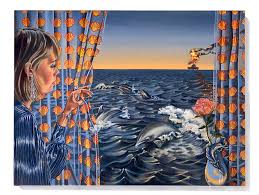 Within the worldview of Buddhism . . . : there is suffering, and it is our job to try to end it; and the perfection of things as they are is already here around us. We cannot escape from perfection, we cannot escape from suffering, most of the time. And they are not separate. How we feel them is the weather of this moment and the spiritual tenor of who we are . . . in our lives.
Within the worldview of Buddhism . . . : there is suffering, and it is our job to try to end it; and the perfection of things as they are is already here around us. We cannot escape from perfection, we cannot escape from suffering, most of the time. And they are not separate. How we feel them is the weather of this moment and the spiritual tenor of who we are . . . in our lives.
But I hope there is no human being who has not had one moment, at least, when they stood in the world, undone by awe and radiance, and the small self vanishes, and you understand the world as immense and yours, and not yours.
. . . the great gate to abundance is simply to feel yourself able to be porous, to be open to whatever is put in the bowl that is yours to hold with your 10 fingers and 54 bones. And that is abundance.
Let’s begin our practice. You might take a few deep slow breaths and feel the pulse of life inside you. I invite you to feel your body. You might sense over the contours of your face and neck. Sense your arms and hands, chest and belly, legs and feet. I invite you to notice how your body arises from Earth’s body. Feel Earth supporting you. You can sense your aliveness: the water bathing, flowing and pooling inside. You can sense the inner fire of the body’s metabolic workings. Feel the currents of air moving through lungs into tissues and cells.
 What is it like to open to the breath? When the breath comes in, can there be a welcome for the energy that sustains you? Can you sense the body as a field of energy? You don’t have to try, see if you can let the awareness surface. If it’s very quiet or subtle that’s o.k. Notice how effortless it is to be part of the greater field of life’s energy. Our individual “Me’s” are nourished as we breathe in. We, in turn, are nourishing green beings – bacteria, algae, plants and forests. We are nourishing our “We” as we breathe out. What is it like to release the breath? Our very act of breathing takes us beyond the edges of our skin.
What is it like to open to the breath? When the breath comes in, can there be a welcome for the energy that sustains you? Can you sense the body as a field of energy? You don’t have to try, see if you can let the awareness surface. If it’s very quiet or subtle that’s o.k. Notice how effortless it is to be part of the greater field of life’s energy. Our individual “Me’s” are nourished as we breathe in. We, in turn, are nourishing green beings – bacteria, algae, plants and forests. We are nourishing our “We” as we breathe out. What is it like to release the breath? Our very act of breathing takes us beyond the edges of our skin.
As you’re ready you might explore what it is like to experience this kinship with all creation. I invite you to reflect on some being, some more than human kin, you hold most dear. We belong to the family of trees, flowers, four leggeds, winged ones, soil and rocks. We belong to the fresh and salty waters, the scaled and hard shelled ones. Who or what have you seen and heard? Who or what do you imagine you could give your love to?
Our love enlivens our imagination. Can you bring your loving imagination to the world?
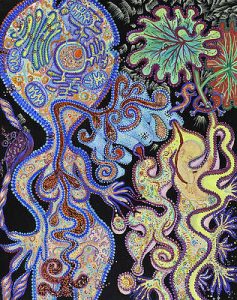 Our inter-relationship is so intimate. We are capable of suffering with our world. Our compassion enables us to recognize our profound inter-being. Our willingness to care and feel is an expression of our love. It is a measure of our open heart, and as our heart breaks open there will be room for the world to heal. Together we realize the shift from “Me” to “We” bringing forth one compassionate act at a time.
Our inter-relationship is so intimate. We are capable of suffering with our world. Our compassion enables us to recognize our profound inter-being. Our willingness to care and feel is an expression of our love. It is a measure of our open heart, and as our heart breaks open there will be room for the world to heal. Together we realize the shift from “Me” to “We” bringing forth one compassionate act at a time.
Perhaps in this way we – as Jane says – can “[stand] in the world undone by awe and radiance. . . [our] small self vanishes, and [we] understand the world as . . . [ours] and not [ours.] Perhaps “the great gate to abundance is simply to feel . . . able to be porous, to be open to whatever is put in the bowl that is yours to hold with your 10 fingers and 54 bones. And that is abundance.”

